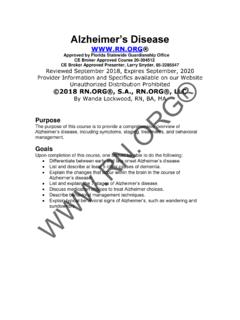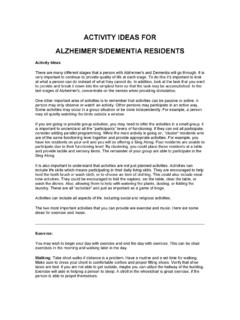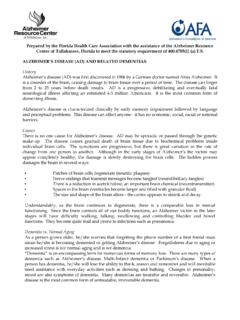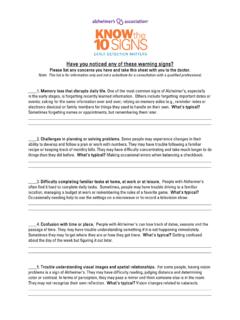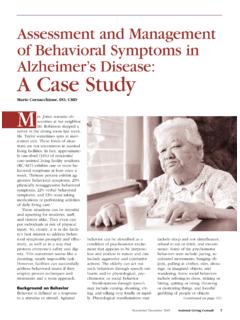Transcription of Alzheimer’s Disease Teaching Plan - mpsi.biz
1 alzheimer s Disease Teaching plan To use this lesson for self-study, the learner should read the material, do the activity, and take the test. For group study, the leader may give each learner a copy of the learning guide and follow this Teaching plan to conduct the lesson. Certificates may be copied for everyone who completes the lesson. Learning objectives Participants will be able to: Recognize signs of alzheimer s Disease (AD). Apply suggestions that may make caring for the AD client easier. Use techniques for handling difficult behaviors in a compassionate way.
2 Discussion Ask participants to remember a time when they faced an unfamiliar situation. The first day of a new job, for example, usually requires talking to strangers, figuring out unfamiliar routines and tasks, and getting around in a strange building. Encourage the learners to tell you how they feel in such situations. Some natural feelings include confusion, puzzlement, nervousness, insecurity, or even fear. Explain to participants that a person with alzheimer s Disease feels this way all the time.
3 The world is more puzzling to them every day. Everyone seems to be a stranger, nothing seems familiar, and abilities they used to have are gone. When we try to see situations from the point of view of the person with alzheimer s, it is easy to understand why they are sometimes anxious, irritable, or upset. Lesson activities Distribute index cards or paper. Ask each learner to write down a problem or question about caring for people with alzheimer s Disease . Have the learners fold the papers or cards and place them in a box or basket you provide.
4 Hand out copies of the learning guide. Have each learner draw a card from the basket. Instruct the learners to read the learning guide and try to find an answer to the question or problem. Allow enough time for everyone to find their answer, and then ask learners to read their question or problem aloud to the group and explain the answer they found. If there is no answer for the problem in the learning guide, have learners discuss possible solutions based on the principles in the lesson. Discuss the important points of the lesson then have learners complete the test.
5 Review the test together. Give certificates to learners with at least 7 correct answers. alzheimer s Disease Learning Guide What it is Causes Complications Treatment Prevention and research Signs Caring for the AD client What it is alzheimer s Disease (AD) is the most common form of dementia. More than 4 million Americans have AD. The Disease is characterized by memory loss, language deterioration, poor judgment, and an indifferent attitude. Dementia is a brain disorder that seriously affects a person s ability to carry out daily activities.
6 It involves the parts of the brain that control thought, memory, and language. Healthy brain tissue dies or deteriorates, causing a steady decline in memory and mental abilities. AD is not the only form of dementia. Doctors diagnose alzheimer s Disease by doing tests to eliminate all the other possible reasons for the person s symptoms. If no other cause is found, usually a diagnosis of alzheimer s is given. AD causes progressive degeneration of the brain. It may start with slight memory loss and confusion, but eventually leads to severe, irreversible mental impairment that destroys a person s ability to remember, reason, learn, and imagine.
7 Usually, family members notice gradual not sudden changes in a person with AD. As AD progresses, symptoms become serious, and family members usually seek medical help. Progression from simple forgetfulness to severe dementia might take five to ten years or longer. People with mild AD may live alone and function fairly well. People with moderate AD may need some type of assistance. People with advanced AD generally require total care. Causes Think of the way electricity travels along wires from a power source to the point of use.
8 Messages travel through the brain in a similar way, but they are carried by chemicals instead of wires. Information travels through the nerve cells in the brain so we can remember, communicate, think, and perform activities. Researchers have found that people with AD have lower levels of the chemicals that carry these important messages from one brain cell to another. In addition, people with AD have many damaged or dead nerve cells in areas of the brain that are vital to memory and other mental abilities.
9 Although the person s mind still contains memories and knowledge, it may be impossible to find and use the information in the brain because of AD. Abnormal structures called plaques and tangles are another characteristic of AD. Plaques. It is believed that plaque deposits form between brain cells early in the Disease process. Tangles. This refers to the way that brain cells become twisted, causing damage and nerve cell death. These structures block the movement of messages through the brain, causing memory loss, confusion, and personality changes.
10 The person with AD has no control over these symptoms and cannot be held responsible for behavior problems. Complications Most people with AD die from another illness, not from AD. In advanced AD people lose the ability to do normal activities and care for their own needs. They may have difficulty eating, going to the bathroom, or taking care of their personal hygiene. They may wander away, get lost, or become injured. They may develop complicating health problems such as pneumonia, infections, falls, and fractures. Treatment There is no cure.



